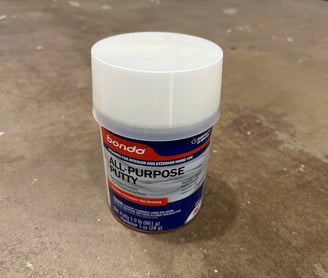Bondo: A Very Versatile Epoxy
VARIETIES OF ADHESIVESFEATURED


This blog post explores the wide array of applications for Bondo, highlighting its versatility in repair and restoration projects while also addressing its limitations and the importance of proper usage.
Bondo: Unveiling Its Versatile Uses and Limitations
In the realm of repair and restoration, few products are as versatile as Bondo. This remarkable material has earned a reputation as a go-to solution for countless DIY enthusiasts, builders, and artisans. However, as with any tool, Bondo has its strengths and limitations. In this blog post, we'll embark on a journey through the myriad applications of Bondo, while also shedding light on the situations where it might not be the ideal choice.
The Marvelous World of Bondo:
Automotive Repairs: Bondo is renowned for its effectiveness in auto body repairs, from filling dents and rust holes to shaping and smoothing surfaces. It's a staple for restoring vintage cars and modern vehicles alike.
Woodworking Wizardry: Crafters and woodworkers appreciate Bondo for filling voids, repairing furniture, and restoring wooden surfaces. Its excellent sanding and shaping properties make it a valuable asset.
Home Renovations: Bondo can work wonders in home improvement projects, from repairing damaged drywall to patching holes in concrete. It offers a reliable, long-lasting solution for various repair needs.
Sculpting and Prototyping: Artists and sculptors often turn to Bondo for creating sculptures and prototypes due to its malleability and strength, allowing for intricate designs and fine details.
Boat and Marine Repairs: Bondo's resistance to water and its ability to bond with fiberglass make it a preferred choice for patching and restoring boats and other marine equipment.
Limitations to Consider:
Not Suitable for Load-Bearing Areas: Bondo is not intended for structural repairs or load-bearing applications. For such tasks, it's crucial to use materials specifically designed for structural support.
Temperature Sensitivity: Bondo's performance can be affected by extreme temperatures. It may become brittle in cold weather or lose its shape in excessive heat.
Proper Application is Key: Achieving optimal results with Bondo requires proper preparation, mixing, and application techniques. Rushing through these steps can lead to unsatisfactory outcomes.
Limited Bonding Materials: While Bondo adheres well to various surfaces, it may not bond effectively with certain materials. It's essential to consider compatibility when choosing Bondo for a project.
Conclusion:
Bondo is undoubtedly a versatile and invaluable tool for a wide range of applications, offering a reliable solution for repairs, restorations, and creative endeavors. Its ability to fill gaps, shape surfaces, and provide a smooth finish makes it a favorite among DIYers and professionals alike. However, it's essential to recognize its limitations and use it judiciously, ensuring that it's the right tool for the job at hand. With this understanding, you can harness the full potential of Bondo while achieving outstanding results in your projects.
